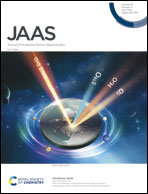Fine tuning laser focus for improved reproducibility of U–Pb isotope analysis by LA-ICP-MS†
Abstract
Several reference zircons, titanite, rutile and NIST 610 glass were analyzed to evaluate a previously underappreciated source of error in U–Pb isotope determination associated with laser focus. We show that a variation of >30 μm in laser focus can occur for both manual and automatic focusing during routine operation. Using two independent laboratories with different LA systems but using similar laser parameters (a laser fluence of 2 J cm−2, a circular spot of 20 μm, and a repetition rate of 4–5 Hz), we further demonstrate that the variation of laser focus by 30 μm can lead to a systematic shift in 206Pb/238U of <1% for NIST 610, ∼3% for titanite, 4–6% for zircon, and up to 12% for rutile. The impact of defocusing on U–Pb isotope determination does become weaker when the diameter to depth ratio increases. On the other hand, focus variation has a minimal impact on the fractionation between 206Pb and 207Pb, and as a result can cause false discordancy of data points in concordia plots. The error associated with laser focus can lead to increased uncertainty and poorer reproducibility in the determination of elements and isotopes. When the laser focus is accurate to within 5 μm, the influence of the focus offset is smaller than the analytical uncertainty and repeatability is enhanced particularly for high precision U–Pb isotope analysis by LA-ICP-MS.



 Please wait while we load your content...
Please wait while we load your content...